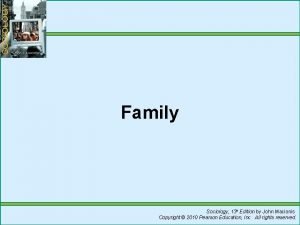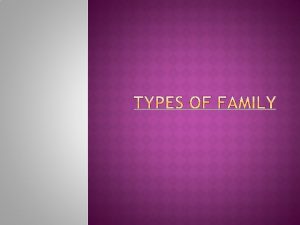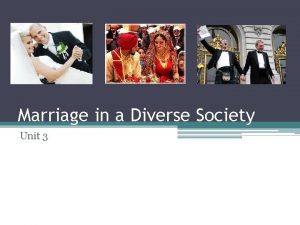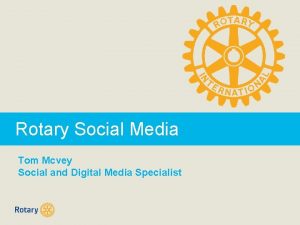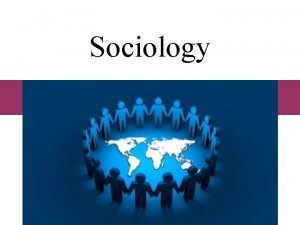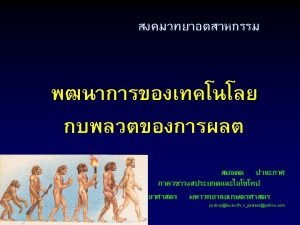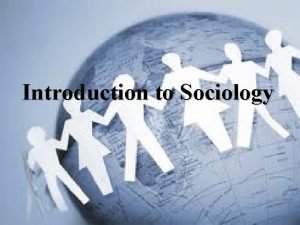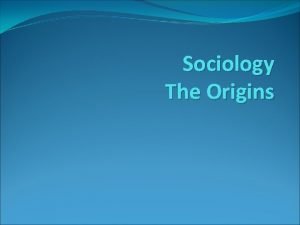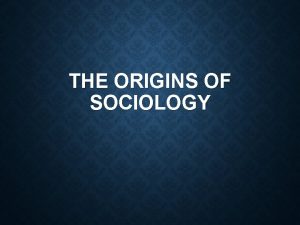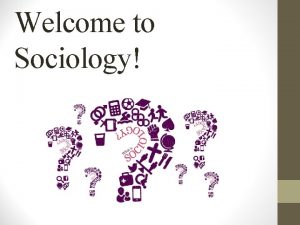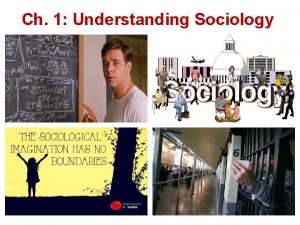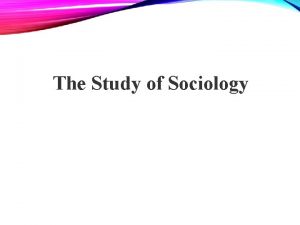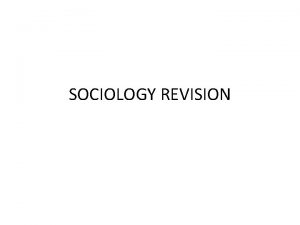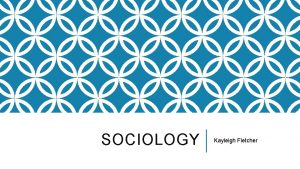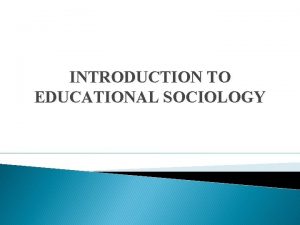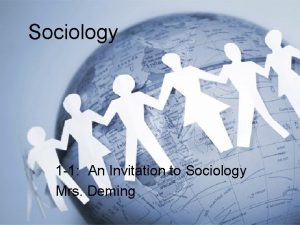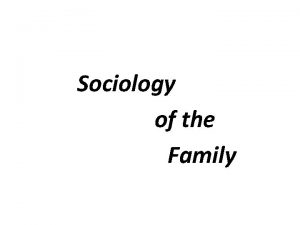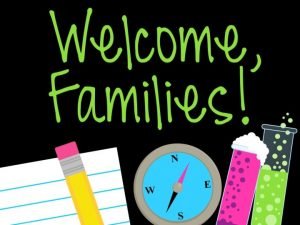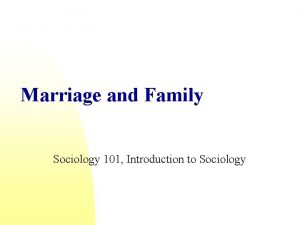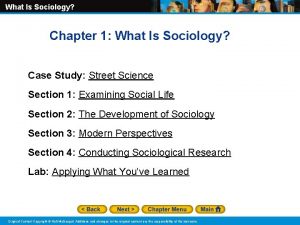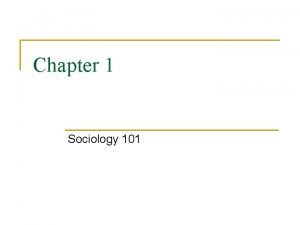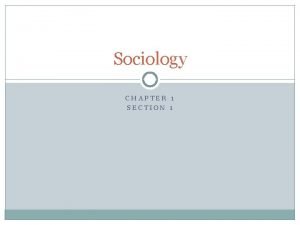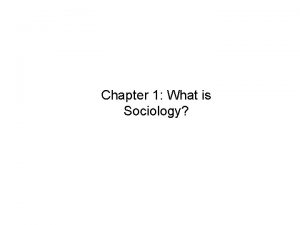Chapter 11 The Family SOCIOLOGY MRS MCVEY Family


























- Slides: 26

Chapter 11: The Family SOCIOLOGY MRS. MCVEY

Family Keep your paper face down and write down your definition of family What does family mean to you? What does family look like? What is a family’s responsibility?

Family Flip the paper over and read the 10 definitions of family Which one do you think is the best definition? Star it. Which definition is the worst? Put an “X” by it. What is wrong with the definitions? What makes them incomplete or not fit with your idea of what is family?

What is family? Lots of definitions and they vary from person to person, culture to culture Families can look very different Text defines family as a group of people related by marriage, blood, or adoption open to chapter 11 Page 357

Orientation v. Procreation Family of orientation is the family you are BORN into Family of procreation is the family you make when you are “married” (according to the book) Marriage is a legal union based on mutual rights and obligations

Family structures Two most common types are nuclear family and extended family Nuclear family is mom, dad, and kids (most common in U. S. ) Extended family is made up of two or more adult generations of the same family who share money and live in the same house (for example: your grandma lives with you, your parents, and your siblings)

Family structure P = “papa” = dad Patrilineal is when descent and inheritance passed from father to male descendants Patriarchy is when the oldest MAN in the household has authority Patrilocal is living with or near husband’s parents

Family Structure M = “mama” = mom Matrilineal is when descent and inheritance is passed from mother to female descendants Matriarchy is when the oldest FEMALE has the authority Matrilocal is living with or near the wife’s parents

Family Structure Equalitarian (=) authority is split evenly between husband wife Neolocal married couples establish own residences Bi = two = share Bilateral passed equally through both parents

Marriage Arrangements Monogamy (mono = 1) marriage of one man to one woman Polygamy (poly = more than 1) marriage of a male or female to more than one person at a time Polygyny: Marriage one man and two or more wives Polyandry: Marriage of one woman to two or more men

Choosing a Mate Exogamy: marrying outside one’s group Incest taboo forbids marriage between close relatives Endogamy: marrying within one’s social group Homogamy: marry someone similar to yourself Most marry within same social class, similar education levels, about the same age Heterogamy: marry someone with different social characteristics Age, interracial relationships, social class

Family Tree

How related are you?

Functionalism & Family Socialization Socioemotional Maintenance: provision of acceptance and support Reproduction Regulate sexual activity Transmit social status Economic function: work to feed, take care of, etc.

Transmit Social Status

Conflict Theory & Family Focus on family members compete & cooperate Focus on patriarchal/patrilineal Males dominant and in control Males make money and make decisions Females are submissive Females cook, clean, attend to house

Symbolic Interactionsim & Family Key to understanding behavior is the interaction among family members and the meaning behind the interactions Socialization Relationships in the family constantly change Child self-concept

Family & Marriage in the U. S. Families are nuclear Families are bilateral Families are democratic (equal decision making) Families are neolocal (live apart from other families) Families are monogamous

Same-sex marriage in the United States CNN interactive map as of November 2014 http: //www. cnn. com/interactive/us/map-same-sex- marriage/

The State of Gay Marriage


http: //www. freedomtomarry. org/states/entry/c/ne braska

Marriage/Divorce Marriage rate: # of marriages per year for every thousand members of the population Divorce rate: # of divorces per year for every one thousand members of the population Causes of divorce Age of marriage How many years the partners have been married Nature/quality of relationship

What does the future for marriage look like? Marriages future looks pretty positive…. . Average of 1 st marriage increasing (lessen divorce rate) Average of population increasing (lessen divorce rate) American couples have fewer children and/or spaced farther apart (reducing pressure on marriage)


 They are mrs garcia and mrs castro
They are mrs garcia and mrs castro They are mrs garcia and mrs castro
They are mrs garcia and mrs castro Mrs. darling was ___________ of mrs. s.
Mrs. darling was ___________ of mrs. s. Igcse sociology family notes
Igcse sociology family notes Nuclear family definition sociology
Nuclear family definition sociology Cereal packet family definition
Cereal packet family definition Family definition sociology
Family definition sociology Hình ảnh bộ gõ cơ thể búng tay
Hình ảnh bộ gõ cơ thể búng tay Frameset trong html5
Frameset trong html5 Bổ thể
Bổ thể Tỉ lệ cơ thể trẻ em
Tỉ lệ cơ thể trẻ em Voi kéo gỗ như thế nào
Voi kéo gỗ như thế nào Thang điểm glasgow
Thang điểm glasgow Chúa sống lại
Chúa sống lại Kể tên các môn thể thao
Kể tên các môn thể thao Thế nào là hệ số cao nhất
Thế nào là hệ số cao nhất Các châu lục và đại dương trên thế giới
Các châu lục và đại dương trên thế giới Cong thức tính động năng
Cong thức tính động năng Trời xanh đây là của chúng ta thể thơ
Trời xanh đây là của chúng ta thể thơ Mật thư tọa độ 5x5
Mật thư tọa độ 5x5 Làm thế nào để 102-1=99
Làm thế nào để 102-1=99 Phản ứng thế ankan
Phản ứng thế ankan Các châu lục và đại dương trên thế giới
Các châu lục và đại dương trên thế giới Thơ thất ngôn tứ tuyệt đường luật
Thơ thất ngôn tứ tuyệt đường luật Quá trình desamine hóa có thể tạo ra
Quá trình desamine hóa có thể tạo ra Một số thể thơ truyền thống
Một số thể thơ truyền thống Bàn tay mà dây bẩn
Bàn tay mà dây bẩn




